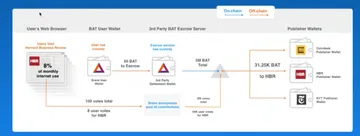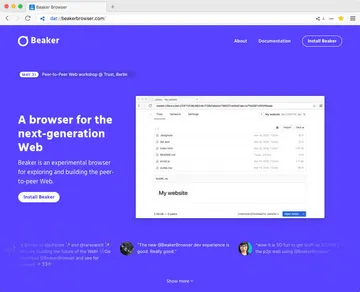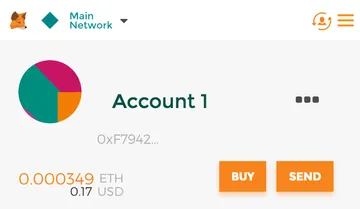Are These Browsers Going to the Moon?

Leo Bauza, Former Front-End Development Technical Director
Article Category:
Posted on
Modern browsers saved front-end developers everywhere, but can these browsers save us all?
Chrome, Safari, Firefox, Edge, and (unfortunately) Internet Explorer are the most popular browsers today, and they are great. They have awesome features, sweet add-ons, and most people never give them a second thought. This post is not about those browsers, it’s about the other browsers. Browsers that can help users stay anonymous and protect their identity. Browsers that can eliminate ads and support publishers and content creators through cryptocurrency micropayments. Browsers using new protocols that promise a truly decentralized internet. Browsers that double as cryptocurrency wallets and connect users to what the, perhaps too optimistic call "web 3.0." Coming up are four browsers that may change the way we think about the internet.
Brave Browser: The micropayments experiment #
The Brave Browser (for Desktop) has a bunch of cool features. Brave is a micropayments platform using their own ERC20 token (BATs), it is an ad blocker, and it allows users to browse using Tor private tabs. I haven’t made a complete switch to this browser only because the front-end developing experience isn’t as good as Chrome’s, a very web-engineer-specific reason.

Brave’s ad and tracker blocker is part of their mission to deliver web pages faster and more securely. Ads and trackers slow down web pages and create data leaks. Our data team may kill me for saying this but, a large chunk of the data we download on the web is totally useless; it’s tracking codes and ads. This costs users money when not connected to a wifi network on their phones and slows down their experience no matter how they browse. Eliminating ads and trackers immediately improves the web browsing experience.
Brave understands that publishers need to make money somehow and that’s where their micropayments platform steps in to fill the gap the ad-blocking creates. Viget’s own blog is set up as a Brave Publisher, so if you are browsing with Brave you can add viget.com as one of the publishers you contribute your made up internet money to. This system isn’t without its problems. Setting up a wallet and getting on-boarded had the type of friction you’d expect from any crypto project. The wallet system they’ve chosen is somewhat centralized right now. Finally, getting people to actually use this will be difficult. Brave has been airdropping BATs to users to bootstrap the network. So far, so good, but it’s still too early to tell if this brave new way of monetizing content will work.

Micropayments aren’t all Brave has to offer though. Private tabs in traditional browsers can hardly be called “private.” Brave changes that by adding private tabs using Tor (The onion router). With Tor tabs you get improved security and privacy while browsing, this is what a “private tab” is supposed to be. This feature of Brave is really exciting and one of the reasons I am a fan. For those who are not familiar with Tor, stick around, we’ll get there. It’s important to know that Tor tabs are in beta, and if you are a dissident in a dangerous part of the world you should be using something safer.
The biggest downside to using Brave has been its performance. It was bad, but it has improved. Brave is a new browser built on Muon (a fork of Electron), so I would expect it to not be fully optimized yet; after all, I am told Electron makes it very easy to drain resources. During a recent presentation Brendan Eich, Brave’s founder and creator of the JavaScript language, talked about the reason for tech decisions as well as giving an in-depth look at what is next for Brave.
Tor Browser: Not just for illegal stuff #
The Tor browser bundles up security features to give users a more private and secure experience on the web. Some may think that Tor is for people trying to surf the dark web and buy all sorts of illegal stuff paid for with bitcoin, and they are partly right. Maybe don’t do that, since that’s illegal.
Tor works by hiding you amongst all other users in the network. When a user makes a request to a server via Tor, the request is encrypted multiple times and a path through multiple Tor nodes is determined. Each node peels a layer of encryption from the original request and routes it to the next node, hence the name Tor (The onion router.) This goes on until the request reaches an exit node. The exit node will make an unencrypted request to the server and then the process will repeat in reverse through a different path of Tor nodes.
People who’d like to browse the internet without being tracked can do so with Tor. Journalists use Tor to receive communications through Secure Drop, a system publications can set up that requires the use of Tor onion services. Non governmental organization (NGO) workers use Tor to connect to their home website without giving away that they work for that NGO. Dissidents in dangerous parts of the world can view censored content. Various government agencies have even helped fund Tor. They can use Tor to make sure not to leave behind government IP addresses while surveilling websites. Anyone who wants to anonymise their traffic for any reason can do so with Tor.

Publications as big as The New York Times and applications as well known as Facebook both have onion services. These allow for even more privacy and security by obscuring the destination of a request as well as the point of origin. As Runa Sandvik, Director of Information Security at The New York Times, explains in a Medium post, onion services and the Tor browser assure that their website can be reached “without monitors or blocks” and “ they provide additional guarantees that readers are connected securely to [their] website.”
The EFF (Electronic Frontier Foundation) has a great interactive graphic showing how the combination of Tor and HTTPs protects users while browsing the internet, I would encourage anyone to check it out. With Tor and HTTPs, users can obscure their identity, location, data, site they are visiting, and username/password from various different people/agencies while connecting to any site or service on the internet. Tor is not a silver bullet. Anyone trying to protect themselves online must take multiple steps to do so, but using the Tor browser is a good start.
Beaker: Peer-to-peer without all the cryptocurrency nonsense #
Instead of HTTP, Beaker uses Dat – a peer-to-peer protocol that claims to be modeled after “the best parts of Git, BitTorrent, and the internet.” This is a new decentralized way of hosting a website or app, the protocol allows for syncing of files across distributed networks. Dat is also private and encrypted by default, a must in pretty much any decentralized protocol.

The Beaker browser allows for the creation of serverless websites and apps. Each Beaker user connects to other Beaker users, sharing files, and then seeding those files helping to keep any app or website online. Users start seeding a site as soon as they visit it and stop seeding it as soon as they leave. They can opt out of that feature, or they can help the network even more by opting to seed the site for a longer period of time.
Beaker is part of an emerging move towards decentralization. What I find most interesting about Beaker’s approach is that they don’t seem to have a lot of love for cryptocurrencies. Not that they are against them, but they seem to be trying a different model than that of Bitcoin or Ethereum. Cryptocurrency fans would say that this ignores a crucial aspect for achieving decentralization: the right incentives. Beaker meanwhile wonders if you can achieve the same thing without relying on the native tokens that provide “the right incentives.”
As with any decentralized system, there are huge limitations; after all, centralization is how we have great search engines, massive social networks, and why we don’t need our computers to cache large amounts of data and code. As the general public has recently found out, centralization comes at a high cost. That’s the reason Beaker exists, and why decentralization has become such an active space. Paul Frazee, who works on the Beaker browser is aware of this and recently demoed fritter, an app that is pushing what dat and Beaker can do.
The Implications of Beaker succeeding are simple. Users would be able to own their data and the internet would work a lot more like most people assumed the internet worked, until they realized it didn’t.
Toshi/Status: Peer-to-peer with all the cryptocurrency goodness #
Technically these are two browsers: Toshi and Status for both iOS and Android. They are your gateway to decentralized applications (dApps) running on the Ethereum Blockchain. Both of these browsers are trying to fix the convoluted UX mess associated with dApps. To do this they add some key pieces of functionality to the traditional browser. First, a curated dApp “store” to aid with discoverability; second, an integrated cryptocurrency wallet to reduce transaction friction; and finally, chat functionality to provide secure peer-to-peer conversations and transactions.
The dApp store is a collection of websites organized in an app-store-like way. For example, cryptokitties exists as a normal website you can access on any browser. Discoverability is a problem for regular apps but it’s particularly important for the right dApps to be discovered, that is, the dApps that are actually usable. Once a user discovers a dApp and opens it she can use it as she would on any browser with some added UX wins courtesy of Toshi and Status.
Users can choose to interact with a dApp on a regular browser like Chrome, too; the problem is they would need an extension like MetaMask to do anything meaningful in the dApp. Furthermore, they will need ether (the ethereum blockchain native token) to pay for stuff in the dApp. If this all sounds complicated and convoluted, it’s because it is. In general, apps try to reduce friction; in the world of dApps it’d be hard to introduce more friction. The integrated wallet in these browsers replace the clunky MetaMask plugin and make the purchasing experience smoother. It isn’t just the browsers’ job to have a better payment UX, though. dApps are responsible for displaying prices and transaction costs, which they may display in unintelligible ether units or the user’s native currency.

The biggest difference between these two apps is their implementation of the chat feature. Status uses ethereum’s Whisper protocol, a peer-to-peer decentralized communication protocol that, without getting into it, works a bit like Tor and requires no central server. Meanwhile, Toshi uses the Signal protocol by Open Whisper Systems (no relation to the Whisper protocol). The Signal protocol is an end-to-end encrypted communication protocol that does use centralized servers. Implementation aside, having a chat is important for a dApp browser. A native way for users to communicate, and more importantly, send and receive cryptocurrency aids in discoverability and onboarding.
Do These Matter? #
These browsers represent a possible future for the internet. They address the biggest problems users face on the internet today: privacy and security. At the very least these projects pose a threat to existing browsers, websites, and apps. The most pessimistic of optimistic outcomes would be that all these projects move incumbents closer to dealing with privacy and security issues. The most optimistic outcome is that these browsers, each in their own way, will be the way we connect to a better internet.